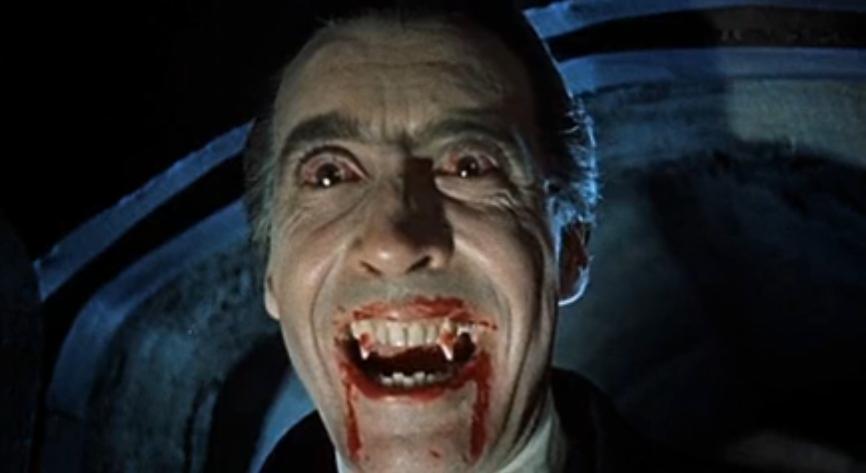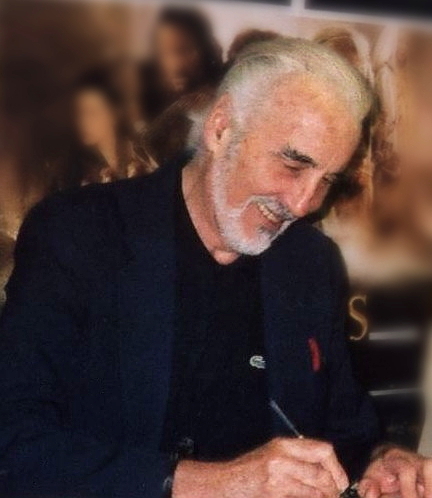Halloween is upon us and our thoughts go back to one of the best Draculas of our youth: Christopher Lee.

in nine films
Sure, Bela Lugosi was the original but he had a black & white existence on screen. Blood isn’t blood unless it’s red. So, when the Brits got into the technicolor horror business they poured the stuff on. In 1958, they introduced the world to actor Christopher Frank Carandini Lee as the new Count in the Horror of Dracula. He went on to play the vampire in eight more films.
Born in England of a British father and Italo-Brit mother in 1922, the man who played Transylvanian Count Dracula was himself of noble Italian roots. His mother Estelle Marie was a countess of the Carandini di Sarzano family. The title of Conte (Count) was bestowed on a Carandini ancestor following the Battle of Lepanto in 1571 where a Turkish fleet was defeated by a combined Latin naval task force. Carandinis were prominent in Italian and papal circles.
It may have been the Carandini ties to the Church that forced them to flee Italy during the Risorgimento. The Church was against any reunification of Italy and the Carandinis had some powerful cardinals in their ancestry. Possibly at odds with the House of Savoy, Christopher Lee’s maternal great-grandfather fled Italy during these years. The family intermarried with Brits. Lee’s mother Estelle was born in India – her father may have been in the British Army. Eventually, the family settled in Australia.
Countess Estelle relocated to England where she married a British Army officer and had Christopher. Christopher wasn’t a chip off the old military block. At military school he often “played dead” during mock battles to avoid further “combat”.
He grew to be a strapping young man of 6’5” with a penchant for singing (baritone) – one of his aunts was a famous singer in Australia – and minor stage acting. When war broke out in 1939 he joined the Royal Air Force, learned to fly but was soon grounded with a damaged optic nerve. His remaining time in the RAF was spent in Intelligence – he was fluent in French, Italian and German which were invaluable during his service in North Africa and then Italy.

While stationed at an airfield just outside liberated Rome Lee met his mother’s cousin, Nicolò Carandini, who had fought in the Italian resistance. It would be a fateful meeting.
When Lee returned to civilian life in London, he pondered his career options. One was to go into teaching Latin; but a chance luncheon with his cousin Nicolò put him on a new course. Nicolò was now Italy’s ambassador to Britain and a man with connections. His cousin happened to have an Italian friend named Filippo Del Giudice, a lawyer-turned-film producer and head of Two Cities Films, part of the Rank Organisation (a British entertainment conglomerate).
Lee entered the movie business in 1947 with bit parts. You might catch a glimpse of him in the 1951 American epic Quo Vadis, playing a chariot driver – he was injured when he was thrown from the chariot at one point. Then came his breakthrough role, not as Dracula but the “creature” in the 1957 movie Frankenstein – a 6’5” creature was just what was called for. Lee’s monster had no electrodes, nor did he speak.
The next year he starred in the Horror of Dracula. Lee added an important layer to his vampire that was missing from the Bela Lugosi version: sexuality. As one critic put it: “Lee’s Dracula is a rampant sex fiend, using that stare to make buxom ladies everywhere come over a little faint.” Lee’s Dracula was listed as the “7th Greatest Horror Movie Character of All Time” by Empire the world’s largest movie magazine.
But Christopher Lee extended his talents beyond horror movies. His 60-year career included parts in Star Wars, Sherlock Holmes and Bond movies, and he played the founder of Pakistan in Jinnah (1998). He also sang and recorded. He was knighted in 2009 for his contributions to the arts.
Sir Christopher Lee died in 2015, shortly after his 93rd birthday…not to rise again! -JLM




The title of that 1957 film was The Curse of Frankenstein.
BTW, I think many women of the 1920’s and 1930’s would not agree that Bela Lugosi’s Dracula lacked sexuality! His menacing and charming aristocratic demeanor was a real turn on back then for the ladies.